Structure and mutagenesis of the parainfluenza virus 5 hemagglutinin-neuraminidase stalk domain reveals a four-helix bundle and the role of the stalk in fusion promotion
- PMID: 21994464
- PMCID: PMC3233124
- DOI: 10.1128/JVI.06350-11
Structure and mutagenesis of the parainfluenza virus 5 hemagglutinin-neuraminidase stalk domain reveals a four-helix bundle and the role of the stalk in fusion promotion
Abstract
Paramyxovirus entry into cells requires the fusion protein (F) and a receptor binding protein (hemagglutinin-neuraminidase [HN], H, or G). The multifunctional HN protein of some paramyxoviruses, besides functioning as the receptor (sialic acid) binding protein (hemagglutinin activity) and the receptor-destroying protein (neuraminidase activity), enhances F activity, presumably by lowering the activation energy required for F to mediate fusion of viral and cellular membranes. Before or upon receptor binding by the HN globular head, F is believed to interact with the HN stalk. Unfortunately, until recently none of the receptor binding protein crystal structures have shown electron density for the stalk domain. Parainfluenza virus 5 (PIV5) HN exists as a noncovalent dimer-of-dimers on the surface of cells, linked by a single disulfide bond in the stalk. Here we present the crystal structure of the PIV5-HN stalk domain at a resolution of 2.65 Å, revealing a four-helix bundle (4HB) with an upper (N-terminal) straight region and a lower (C-terminal) supercoiled part. The hydrophobic core residues are a mix of an 11-mer repeat and a 3- to 4-heptad repeat. To functionally characterize the role of the HN stalk in F interactions and fusion, we designed mutants along the PIV5-HN stalk that are N-glycosylated to physically disrupt F-HN interactions. By extensive study of receptor binding, neuraminidase activity, oligomerization, and fusion-promoting functions of the mutant proteins, we found a correlation between the position of the N-glycosylation mutants on the stalk structure and their neuraminidase activities as well as their abilities to promote fusion.
Figures
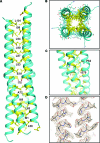
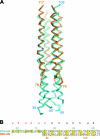
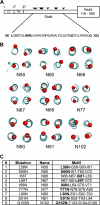
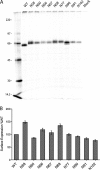

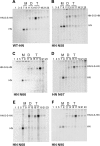



Similar articles
-
Mutagenesis of Paramyxovirus Hemagglutinin-Neuraminidase Membrane-Proximal Stalk Region Influences Stability, Receptor Binding, and Neuraminidase Activity.J Virol. 2016 Aug 12;90(17):7778-88. doi: 10.1128/JVI.00896-16. Print 2016 Sep 1. J Virol. 2016. PMID: 27334593 Free PMC article.
-
Flexibility of the Head-Stalk Linker Domain of Paramyxovirus HN Glycoprotein Is Essential for Triggering Virus Fusion.J Virol. 2016 Sep 29;90(20):9172-81. doi: 10.1128/JVI.01187-16. Print 2016 Oct 15. J Virol. 2016. PMID: 27489276 Free PMC article.
-
Functional analysis of amino acids at stalk/head interface of human parainfluenza virus type 3 hemagglutinin-neuraminidase protein in the membrane fusion process.Virus Genes. 2018 Jun;54(3):333-342. doi: 10.1007/s11262-018-1546-3. Epub 2018 Mar 7. Virus Genes. 2018. PMID: 29516315
-
Paramyxovirus membrane fusion: lessons from the F and HN atomic structures.Virology. 2006 Jan 5;344(1):30-7. doi: 10.1016/j.virol.2005.09.007. Virology. 2006. PMID: 16364733 Free PMC article. Review.
-
Paramyxovirus entry.Adv Exp Med Biol. 2013;790:95-127. doi: 10.1007/978-1-4614-7651-1_6. Adv Exp Med Biol. 2013. PMID: 23884588 Free PMC article. Review.
Cited by
-
Stimulation of Nipah Fusion: Small Intradomain Changes Trigger Extensive Interdomain Rearrangements.Biophys J. 2016 Oct 18;111(8):1621-1630. doi: 10.1016/j.bpj.2016.09.002. Biophys J. 2016. PMID: 27760350 Free PMC article.
-
Sequential conformational changes in the morbillivirus attachment protein initiate the membrane fusion process.PLoS Pathog. 2015 May 6;11(5):e1004880. doi: 10.1371/journal.ppat.1004880. eCollection 2015 May. PLoS Pathog. 2015. PMID: 25946112 Free PMC article.
-
Structural rearrangements of the central region of the morbillivirus attachment protein stalk domain trigger F protein refolding for membrane fusion.J Biol Chem. 2012 May 11;287(20):16324-34. doi: 10.1074/jbc.M112.342493. Epub 2012 Mar 19. J Biol Chem. 2012. PMID: 22431728 Free PMC article.
-
Subnanometer structure of an enveloped virus fusion complex on viral surface reveals new entry mechanisms.Sci Adv. 2023 Feb 10;9(6):eade2727. doi: 10.1126/sciadv.ade2727. Epub 2023 Feb 10. Sci Adv. 2023. PMID: 36763666 Free PMC article.
-
Headless Henipaviral Receptor Binding Glycoproteins Reveal Fusion Modulation by the Head/Stalk Interface and Post-receptor Binding Contributions of the Head Domain.J Virol. 2021 Sep 27;95(20):e0066621. doi: 10.1128/JVI.00666-21. Epub 2021 Jul 21. J Virol. 2021. PMID: 34288734 Free PMC article.
References
-
- Bousse T., Takimoto T., Gorman W. L., Takahashi T., Portner A. 1994. Regions on the hemagglutinin-neuraminidase proteins of human parainfluenza virus type-1 and Sendai virus important for membrane fusion. Virology 204: 506–514 - PubMed
Publication types
MeSH terms
Substances
Grants and funding
LinkOut - more resources
Full Text Sources
Miscellaneous

